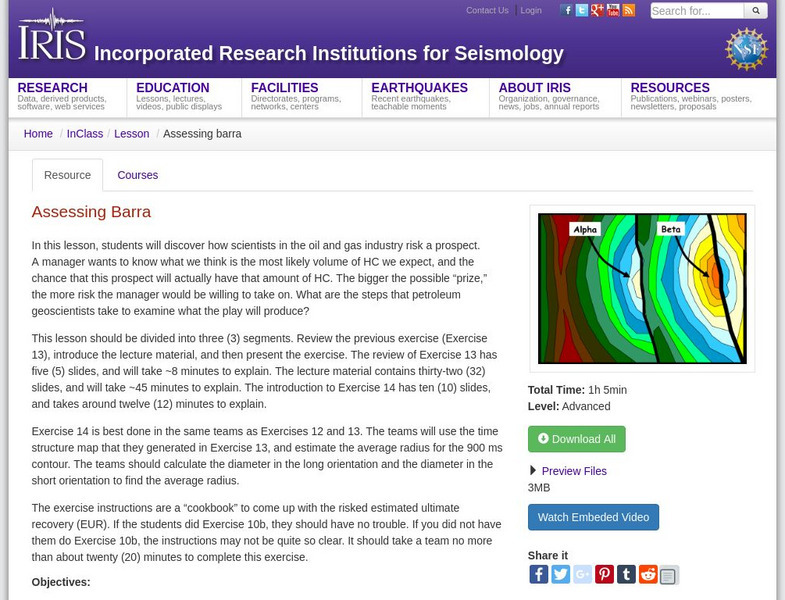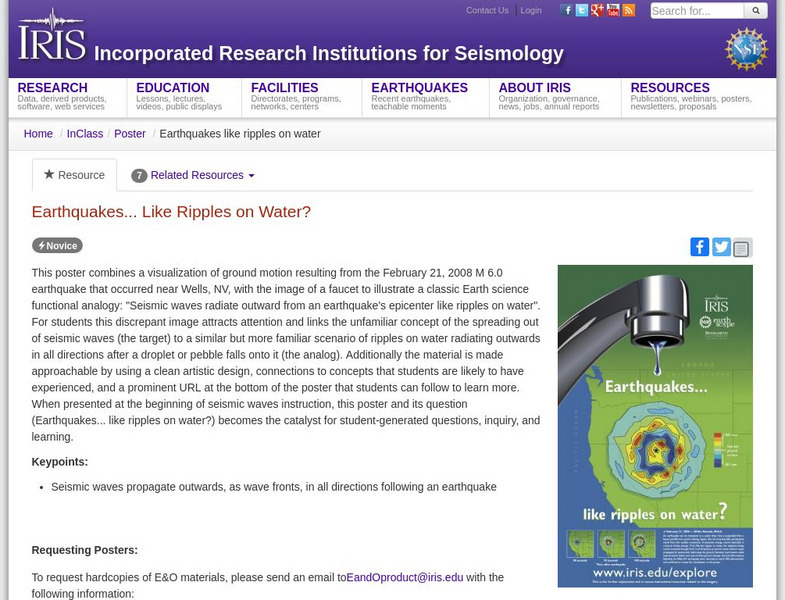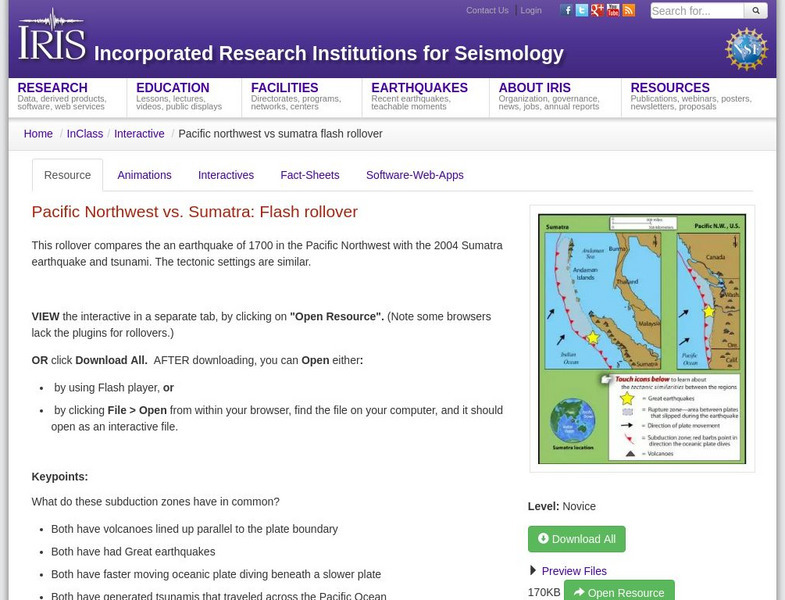Incorporated Research Institutions for Seismology
Iris: Global Seismogram Viewer
Discover the P-wave Shadow Zone and how it can be used to determine the diameter of Earth's outer core.
Incorporated Research Institutions for Seismology
Iris: World: Tectonic Plates
Interactive map of tectonic plates from the US Geological Survey plate tectonic map reveals the plate names when you scroll over the plate.
Incorporated Research Institutions for Seismology
Iris: New Madrid: Sand Blows Are Evidence for Earthquakes
Scroll over this photograph of an excavation to see evidence for prehistoric sand blows. These give evidence for earthquakes and liquefaction in the prehistoric record.
Incorporated Research Institutions for Seismology
Iris: Introduction to Play Elements
A video lecture and practice exercises for students methods used to find hydrocarbons during oil discovery.
Incorporated Research Institutions for Seismology
Iris: Estimating Ultimate Recovery
Through a video lecture and practice exercises, students estimate the ultimate recovery (EUR) of a hydrocarbon prospect.
Incorporated Research Institutions for Seismology
Iris: Development Geology & Geophysics
A video lecture with exercises that prompt students to describe the three (3) major phases of an asset's life, review the exploration phase of an asset and list the key major considerations of the development phase.
Incorporated Research Institutions for Seismology
Iris: Assessing Barra
Through a video lecture and exercises, young scholars discover how scientists in the oil and gas industry risk a prospect.
Incorporated Research Institutions for Seismology
Iris: Can Humans Cause Earthquakes?
A class investigation studying whether or not human factors can cause earthquakes through hydraulic fracturing.
Incorporated Research Institutions for Seismology
Iris: Earthquake Machine 3 Earthquake Prediction: Adi Style Activity
Students work in small groups to use a physical model, the earthquake machine, to examine the occurrence of earthquakes and the inputs and outputs of fault systems.
Incorporated Research Institutions for Seismology
Iris: How Does a Seismometer Work?
An overview of the basic components of a seismometer and physical science principles behind its operation.
Incorporated Research Institutions for Seismology
Iris: Earthquake Magnitude Modeling With Pasta Quake
Using only strands of spaghetti, you and your class can explore the amount of energy released for each level of the earthquake magnitude scale.
Incorporated Research Institutions for Seismology
Iris: How Often Do Earthquakes Occur?
A one-pager that illustrates how often earthquakes occur.
Incorporated Research Institutions for Seismology
Iris: Determining Shallow Earth Structure
Extend students' learning of fundamental physics concepts (reflection, refraction and transmission of energy) through a real-world application.
Incorporated Research Institutions for Seismology
Iris: Seismic Events of Special Interest
This fact sheet highlights some of these recent seismic events that are of special interest because they have caused notable geologic changes to our landscape or devastating destruction to our society.
Incorporated Research Institutions for Seismology
Iris: Earthquakes, Like Ripples on Water?
See how seismic waves propagate outwards, as wave fronts, in all directions following an earthquake.
Incorporated Research Institutions for Seismology
Iris: Earthquake Machine: Demonstration of the 1 Block Model (Introduction)
A demonstration that models earthquakes in the classroom.
Incorporated Research Institutions for Seismology
Iris: Earthquake Machine 1 Defining an Earthquake
In this activity, students work collaboratively in small groups to investigate the earthquake cycle using a mechanical model.
Incorporated Research Institutions for Seismology
Iris: How Hard Does the Ground Shake During a Quake?
This activity asks students to demonstrate how hard they think the ground shakes during an earthquake.
Incorporated Research Institutions for Seismology
Iris: Mysterious Motions Along the Pacific Northwest Coast
In this lab, students investigate mysterious ground motions along the Pacific Northwest Coast.
Incorporated Research Institutions for Seismology
Iris: Pacific Northwest vs. Sumatra: Flash Rollover
This rollover compares the earthquake of 1700 in the Pacific Northwest with the 2004 Sumatra earthquake and tsunami.
Incorporated Research Institutions for Seismology
Iris: Pacific Northwest Earthquake Locations: Flash
The Pacific Northwest is host to three kinds of earthquakes revealed in this interactive.
Incorporated Research Institutions for Seismology
Iris: Investigating a Mine Collapse in Utah
Use seismic data to determine whether or not a 2007 earthquake caused a mine collapse in Utah.
Incorporated Research Institutions for Seismology
Iris: How Are Earthquakes Located?
This illustrated fact sheet shows how S and P waves each travel at varying speeds and therefore arrive at seismic stations at different times.
Incorporated Research Institutions for Seismology
Iris: Arguing Causes of Faults & Folds Sponge Fault Model
Young scholars examine images of faults and folds, then experiment with two models to collect evidence to determine how the structures formed.

























